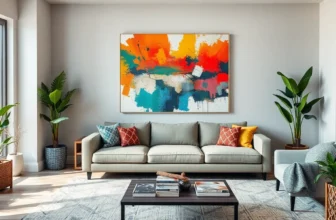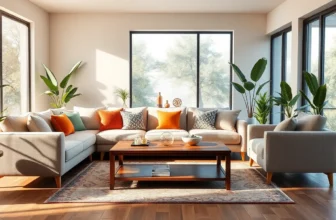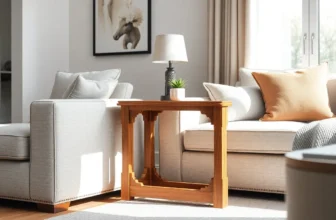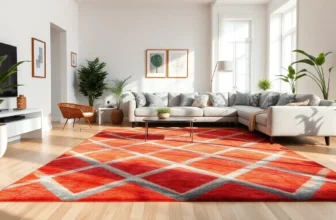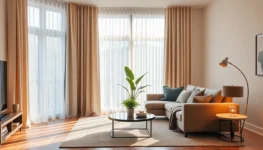
Ultimate Guide to Choosing Curtains for Living Room: Style, Function & Maintenance Tips
Choosing the right curtains for a living room can transform the entire space, adding warmth and style while enhancing privacy and light control. With countless fabrics, colors, and patterns available, selecting the perfect pair can feel overwhelming. Yet, the right curtains not only frame the windows but also complement the overall decor, making a bold statement or creating a serene atmosphere.
From sheer panels that invite natural light to heavy drapes that offer insulation and sound dampening, understanding the options is essential. It’s about finding that ideal balance between functionality and aesthetics. Whether one’s style leans towards modern minimalism or classic elegance, the right curtains can elevate any living room, making it a true reflection of personal taste and comfort.
Curtains for Living Room
Selecting the right type of curtains enhances the living room’s style and functionality. Several options cater to different needs and design preferences.
Sheer Curtains
Sheer curtains maximize natural light while providing a degree of privacy. Made from lightweight fabrics, these curtains soften sunlight and create an airy feel. They often come in various colors and textures, allowing for easy coordination with existing decor. Her sheer curtains work well in layered designs, complementing heavier drapery for added style and versatility.
Blackout Curtains
Blackout curtains excel at blocking out light and improving energy efficiency. Constructed from thick, opaque fabrics, these curtains create a darkened environment ideal for media rooms or bedrooms where sleep is essential. They also help regulate indoor temperatures, reducing heating and cooling costs. Available in numerous styles and colors, blackout curtains can enhance both modern and traditional living spaces.
Drapery Panels
Drapery panels add sophistication and elegance to the living room. Often longer and made from heavier fabrics, these panels offer a more formal appearance. Many options come with varying header styles, such as pleated or grommet tops, allowing easy installation and customization. Drapery panels can also be lined for added insulation or light control, making them a functional yet stylish choice.
Choosing the Right Fabric
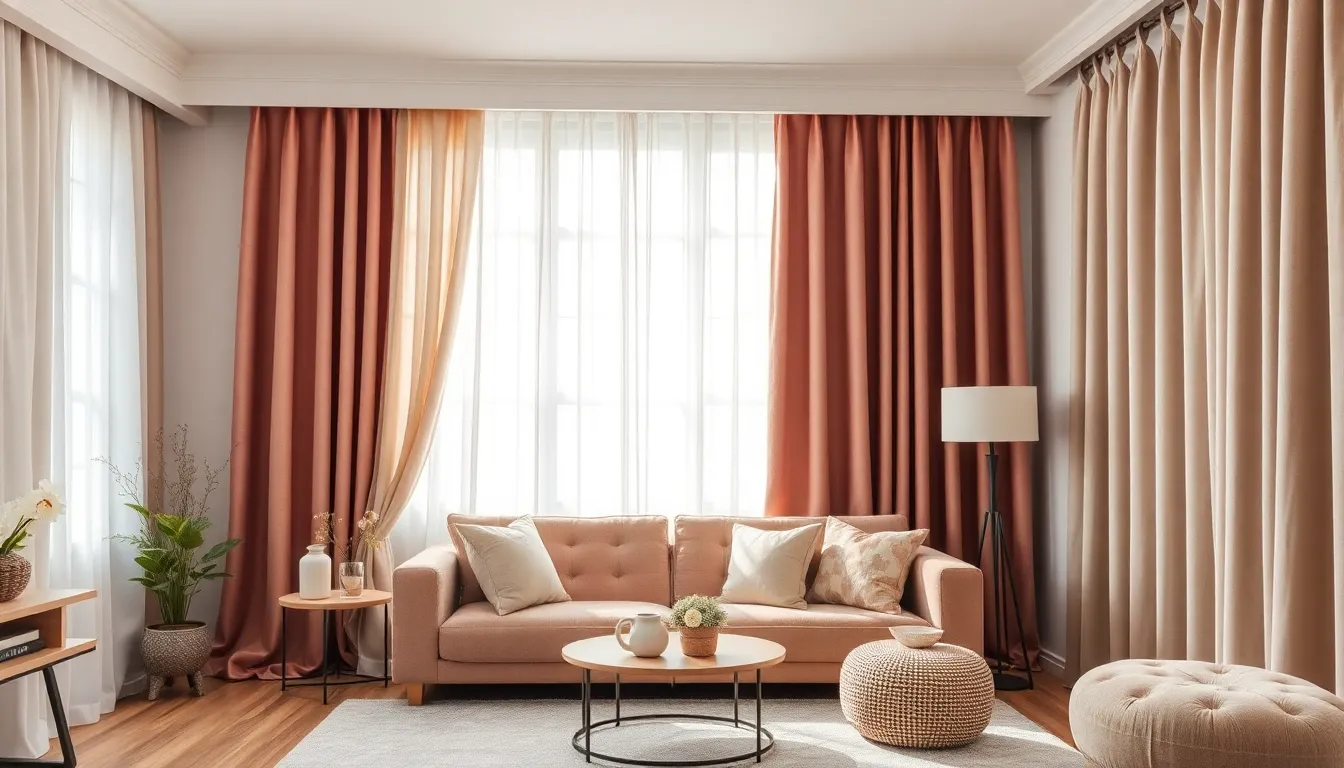
Selecting the right fabric for living room curtains significantly impacts the overall aesthetic and functionality. Different materials offer varying levels of light control, texture, and durability.
Cotton and Linen
Cotton and linen curtains provide a natural, breathable option. Cotton, known for its softness, maintains color well and withstands regular washing. Linen offers a more textured appearance with a classic feel. Both fabrics are versatile, making them suitable for casual or elegant settings. These fabrics allow natural light while offering some privacy, suitable for various styles.
Polyester and Blends
Polyester and its blends present a durable, low-maintenance alternative. Polyester resists wrinkling, fading, and shrinking, making it ideal for high-traffic areas. Blended fabrics can combine the advantages of different materials, resulting in enhanced longevity and texture. These options often mimic the look of natural fibers while providing easy upkeep and affordability.
Velvet and Silk
Velvet and silk curtains exude luxury and sophistication. Velvet adds depth and richness to the decor, offering excellent insulation and light-blocking capabilities. Silk, with its smooth and lustrous surface, enhances elegance but requires more careful maintenance. Both materials work well in formal settings and can elevate the living room style, reflecting personal taste and creating a cozy atmosphere.
Color and Pattern Selection
Choosing the right colors and patterns for living room curtains enhances visual appeal and complements existing decor. A well-considered selection can create a harmonious atmosphere.
Popular Color Trends
Selecting popular colors can significantly influence the living room’s ambiance.
- Neutrals: Whites, beiges, and grays offer a timeless backdrop, allowing other decor elements to stand out.
- Bold Colors: Deep blues, rich greens, and vibrant yellows create striking focal points and can energize the space.
- Pastels: Soft shades like blush, mint, and lavender add subtle warmth and freshness, making the atmosphere inviting.
- Earth Tones: Browns, terracotta, and olive greens connect interiors with nature, promoting a calming environment.
Pattern Options and Styles
Incorporating patterns can add personality and interest to living room curtains.
- Geometric Patterns: Straight lines and shapes provide a modern touch, offering a sleek appearance suitable for contemporary spaces.
- Floral Designs: Classic and romantic, florals bring a touch of nature indoors and work well in traditional settings.
- Stripes: Vertical or horizontal stripes can create the illusion of height or width, respectively, adapting to room proportions.
- Abstract Patterns: Unique, artistic designs appeal to creative homeowners, serving as statement pieces that reflect individual style.
Color and pattern choices play crucial roles in curtain selection, aligning with both personal preferences and overall room aesthetics.
Curtain Length and Mounting
Selecting the appropriate curtain length and mounting style enhances both functionality and aesthetics in a living room.
Measuring Your Space
Measuring space accurately ensures a proper fit for curtains. Start from the top of the window frame to the desired length. Common options include:
- Sill length curtains hang just above the window sill, creating a clean look.
- Apron length extends to a few inches below the window sill, providing a classic appearance.
- Floor length curtains reach the floor, creating elegance and drama.
- Puddle length extends beyond the floor, pooling fabric for added luxury.
Add 2-8 inches to the width measurement for brackets and mounting hardware when installing.
Hanging Styles
Hanging styles significantly affect the look and functionality of curtains. Popular methods include:
- Rod pocket allows fabric to slide easily for a casual look.
- Grommet features metal rings for a contemporary aesthetic and easy opening.
- Pinch pleat combines elegance and structure, with pleats sewn at intervals.
- Tab top has fabric loops, offering a relaxed style that complements informal settings.
Ensure that the chosen style aligns with the overall design theme of the living room while also considering the ease of opening and closing curtains for light control and privacy.
Maintenance and Care
Proper maintenance and care ensure longevity and visual appeal of living room curtains. Regular cleaning and timely replacement keep curtains looking fresh and enhance the overall decor.
Washing and Cleaning Tips
- Check Care Labels: Always refer to the care labels for washing instructions specific to each fabric type. Some fabrics may be machine washable while others require dry cleaning.
- Use Gentle Detergents: Opt for mild detergents that won’t damage the fabric. Avoid bleach, as it can cause discoloration.
- Machine Wash: For washable curtains, use cold water on a delicate cycle to prevent shrinking or damage. Remove curtains promptly to minimize wrinkles.
- Hand Wash: If the fabric is delicate, hand washing with cold water may be more suitable. Gently agitate and rinse without twisting or wringing.
- Drying Methods: Air drying is ideal for most curtains. If using a dryer, choose a low heat setting to avoid fabric damage.
- Spot Clean: For stubborn stains, employ a soft cloth or sponge with a mixture of water and mild detergent. Test in an inconspicuous area first to ensure no discoloration occurs.
- Press with Care: Iron curtains on a low setting if wrinkles remain after washing. Use a pressing cloth to protect delicate fabrics.
When to Replace Curtains
- Fading Colors: Colors fade due to prolonged exposure to sunlight. Once the vibrancy diminishes significantly, consider replacing curtains for a refreshed look.
- Wear and Tear: Inspect for frayed edges, torn seams, or damaged lining. Visible signs of wear compromise aesthetics and may necessitate replacement.
- Outdated Styles: Trends change over time. If the style no longer aligns with current decor, a new set of curtains can rejuvenate the space.
- Allergen Accumulation: Curtains can harbor dust, mold, and allergens. If regular cleaning fails to alleviate allergies, replacement might be necessary for a healthier environment.
- Shifting Decor: If other design elements change within the living space, curtains that no longer complement the overall scheme warrant replacement.
Choosing the right curtains for a living room is a crucial step in creating a space that reflects personal style while enhancing comfort and functionality. With an array of fabrics, colors, and patterns available, it’s essential to consider how each option aligns with the overall decor and purpose of the room.
From sheer curtains that invite natural light to blackout options that ensure privacy, each type serves a unique role. Proper maintenance and care can prolong the life of these decorative elements, ensuring they continue to elevate the living space. Ultimately, thoughtful selection and upkeep of curtains can transform a living room into a warm and inviting retreat.

